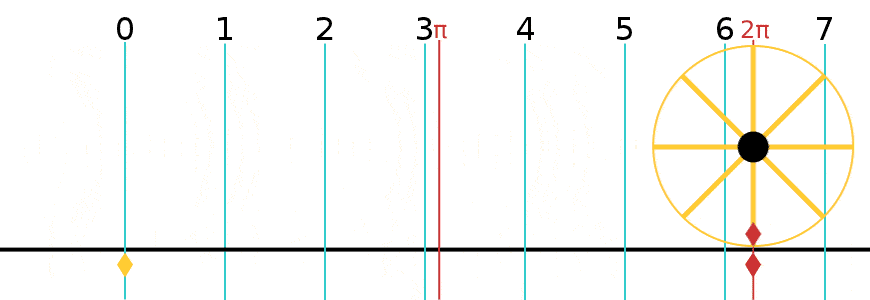A perimeter is a path that surrounds an area. The word comes from the Greek peri (around) and meter (measure). The term may be used either for the path or its length - it can be thought of as the length of the outline of a shape. The perimeter of a circular area is called its circumference.
Contents |
Practical uses [link]

Calculating the perimeter has considerable practical applications. The perimeter can be used to calculate the length of fence required to surround a yard or garden. The perimeter of a wheel (its circumference) describes how far it will roll in one revolution. Similarly, the amount of string wound around a spool is related to the spool's perimeter.
Formulas [link]
| shape | formula | variables |
|---|---|---|
| circle | Failed to parse (Missing texvc executable; please see math/README to configure.): 2 \pi r\, | where Failed to parse (Missing texvc executable; please see math/README to configure.): r
is the radius. |
| triangle | Failed to parse (Missing texvc executable; please see math/README to configure.): a + b + c\, | where Failed to parse (Missing texvc executable; please see math/README to configure.): a
, Failed to parse (Missing texvc executable; please see math/README to configure.): b and Failed to parse (Missing texvc executable; please see math/README to configure.): c are the lengths of the sides of the triangle. |
| square/rhombus | Failed to parse (Missing texvc executable; please see math/README to configure.): 4a | where Failed to parse (Missing texvc executable; please see math/README to configure.): a
is the side length |
| rectangle | Failed to parse (Missing texvc executable; please see math/README to configure.): 2(h+w) | where Failed to parse (Missing texvc executable; please see math/README to configure.): h
is the height and Failed to parse (Missing texvc executable; please see math/README to configure.): w is the width |
| equilateral polygon | Failed to parse (Missing texvc executable; please see math/README to configure.): n \times a\, | where Failed to parse (Missing texvc executable; please see math/README to configure.): n
is the number of sides and Failed to parse (Missing texvc executable; please see math/README to configure.): a is the length of one of the sides. |
| regular polygon | Failed to parse (Missing texvc executable; please see math/README to configure.): 2nb \sin(\frac{\pi}{n}) | where Failed to parse (Missing texvc executable; please see math/README to configure.): n
is the number of sides and Failed to parse (Missing texvc executable; please see math/README to configure.): b is the distance between center of the polygon and one of the vertices of the polygon. |
| general polygon | Failed to parse (Missing texvc executable; please see math/README to configure.): a_{1} + a_{2} + a_{3} + \ldots + a_{n} = \sum_{i=1}^{n}a_{i} | where Failed to parse (Missing texvc executable; please see math/README to configure.): a_{i}
is the length of the Failed to parse (Missing texvc executable; please see math/README to configure.): i -th (1st, 2nd, 3rd ... n-th) side of an n-sided polygon. |
The perimeter is the distance around all of a shape. Perimeters for more general shapes can be calculated as any path with Failed to parse (Missing texvc executable; please see math/README to configure.): \int_0^L \mathrm{d}s
where Failed to parse (Missing texvc executable; please see math/README to configure.): L is the length of the path and Failed to parse (Missing texvc executable; please see math/README to configure.): ds is an infinitesimal line element. Both of these must be replaced with other algebraic forms in order to be solved: an advanced notion of perimeter, which includes hypersurfaces bounding volumes in Failed to parse (Missing texvc executable; please see math/README to configure.): n
-dimensional euclidean spaces can be found in the theory of Caccioppoli sets.
See also [link]
| The Wikibook Geometry has a page on the topic of |
| The Wikibook Geometry has a page on the topic of |
| The Wikibook Geometry has a page on the topic of |
- Isoperimetric inequality
- Circumference
- Caccioppoli set
- Pythagorean Theorem
- Wetted perimeter
- Area
- Volume
External links [link]
| Look up perimeter in Wiktionary, the free dictionary. |
- Weisstein, Eric W., "Perimeter" from MathWorld.
- Weisstein, Eric W., "Semiperimeter" from MathWorld.
https://wn.com/Perimeter
Perimeter (disambiguation)
The perimeter is the distance around a given two-dimensional object.
Perimeter may also refer to:
See also

Perimeter (video game)
Perimeter is a real-time strategy video game developed by K-D Lab for Microsoft Windows. It is published by 1C Company and Codemasters, and was released in 2004.
Plot
Humanity has undergone radical changes in society. Scientists and spiritual leaders became one and the same, calling themselves Spirits. The Spirits, foreseeing the inevitable destruction of Earth due to the ravages of our time, directed scientific efforts into the discovery of a new plane of existence: the Psychosphere. The Psychosphere acted as a conduit, providing means to reach another, untouched world, a new Promised Land, by jumping between flat worlds within the Psychosphere. The Psychosphere is appropriately named, as the various worlds resemble the thoughts and actions that have occurred upon Earth during its history. The Spirits then embarked upon the construction of massive floating city-ships called Frames, which could house hundreds of thousands of people for an indefinite period of time. With the Frames completed, the Spirits sent them forth into the Psychosphere with the intent to lead their people to the Promised Land, leaving Earth behind forever.


